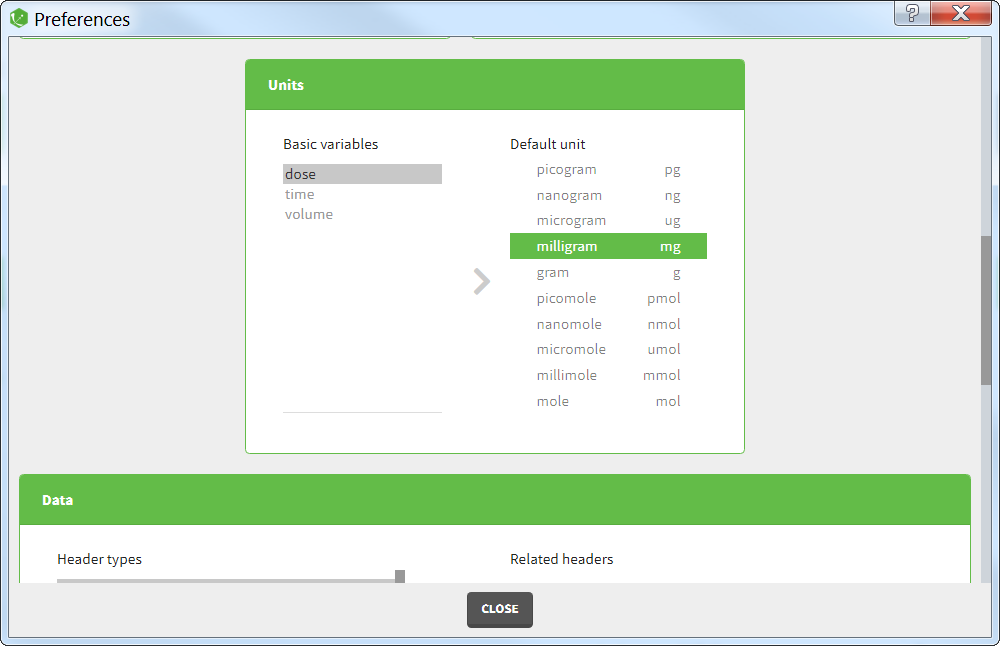Defining units
PKanalix displays units of the NCA and CA parameters calculated automatically from information provided by a user about units of measurements in a dataset. Units are shown in the results tables, on plots and are added to the saved files.
It allows for scaling values of a dataset to represent outputs in preferred units, which facilitates the interpretation of the results. Scaling is done in the PKanalix data manager, and does not change the original data file.
https://www.youtube.com/watch?v=3mzYOgF9LHc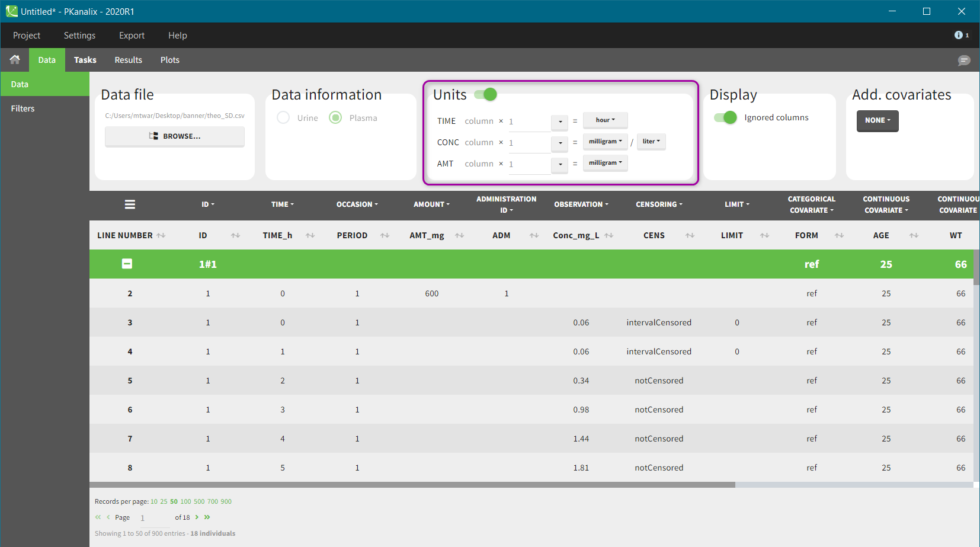
Units definition
Units of the NCA and CA parameters are considered as combinations of units of: time, amount and volume. For instance, unit of AUC is [concentration unit * time unit] = [amount unit / volume unit * time unit]. These quantities correspond to columns in a typical PK dataset: time of measurements, observed concentration, dose amount (and volume of collected urine when relevant).
The “Units” block allows to define the preferred units for the output NCA parameters (purple frame below), which are related to the units of the data set columns (green frame below) via scaling factors (in the middle). The output units are displayed in results and plots after running the NCA and CA tasks.

In PKanalix version 2023R1, the amount can now also be specified in mass of the administered dose per body mass or body surface area. This eliminates the need to edit NCA or CA parameters by post-processing unit conversion.
Concentration is a quantity defined as “amount per volume”. It has two separate units, which are linked (and equal) to AMT and VOLUME respectively. Changing the amount unit of CONC will automatically update the amount unit of AMT. This constraint allows to apply simplifications to the output parameters units, for instance have Cmax_D as [mL] and not [mg/mL/mg].
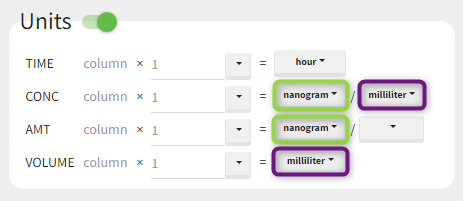
Units without data conversion: Output units correspond to units of the input data.
In other words, desired units of the NCA and CA parameters correspond to units of measurements in the dataset. In this case, select from the drop-down menus units of the input data and keep the default scaling factor (equal to one). All calculations are performed using values in the original dataset and selected units are displayed in the results tables and on plots.
Units conversion: output units are different from the units of the input data.
NCA and CA parameters can be calculated and displayed in any units, not necessarily the same as used in the dataset. The scaling factors (by default equal to 1) multiply the corresponding columns in a dataset and transform them to a dataset in new units. PKanalix shows data with new, scaled values after having clicked on the “accept” button. This conversion occurs only internally and the original dataset file remains unchanged. So, in this case, select desired output units from the list and, knowing units of the input data, scale the original values to the new units.
Example 1: input time units in [hours] and desired output units in [days]
For instance, let measurement times in a dataset be in hours. To obtain the outputs in days, set the output time unit as “days” and the scaling factor to 1/24, as shown below. It reads as follows:
(values of time in hours from the dataset) * (1/24) = time in days.
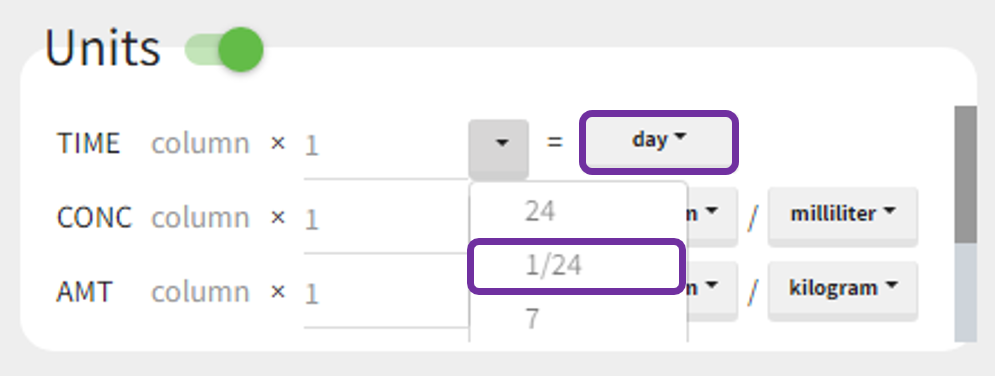
After accepting the scaling, a dataset shown in the Data tab is converted internally to a new data set. It contains original values multiplied by scaling factors. Then, all computations in the NCA and CA tasks are performed using new values, so that the results correspond to selected units.
Example 2: input data set concentration units in [ng/mL] and amount in [mg]
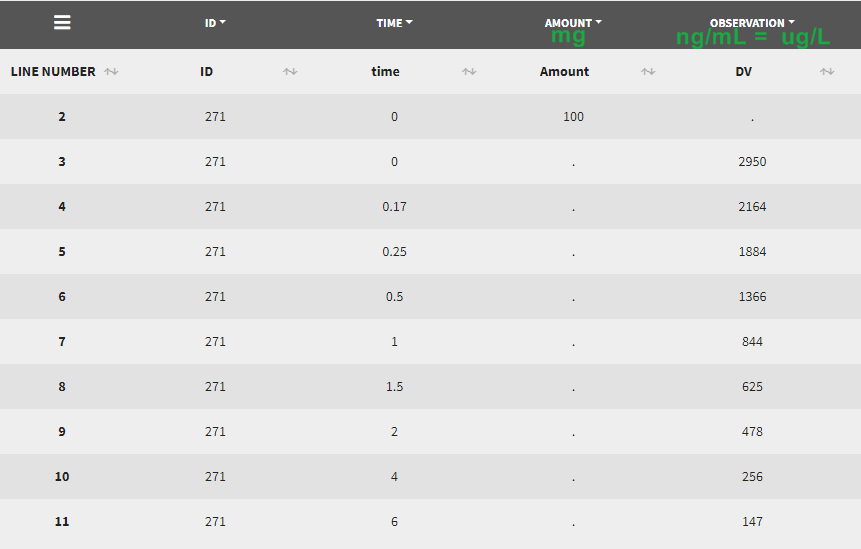
Let’s assume that we have a data set where the concentration units are [ng/mL]=[ug/L] and the dose amount units are [mg], as presented above. It is not possible to indicate these units directly, as the amount unit of CONC and AMT must be the same. One option would be to indicate the CONC as [mg/kL] and the AMT as [mg] but having the volume unit as [kL] is not very convenient. We will thus use the scaling factors to harmonize the units of the concentration and the amount.
If we would like to have the output NCA parameters using [ug] and [L], we can define the CONC units as [µg/L] (as the data set input units) and scale the AMT to convert the amount column from [mg] to [ug] unit with a scaling factor of 1000. After clicking “accept” on the bottom right, the values in the amount column of the (internal) data set have been multiplied by 1000 by PKanalix such that they are now in [µg].
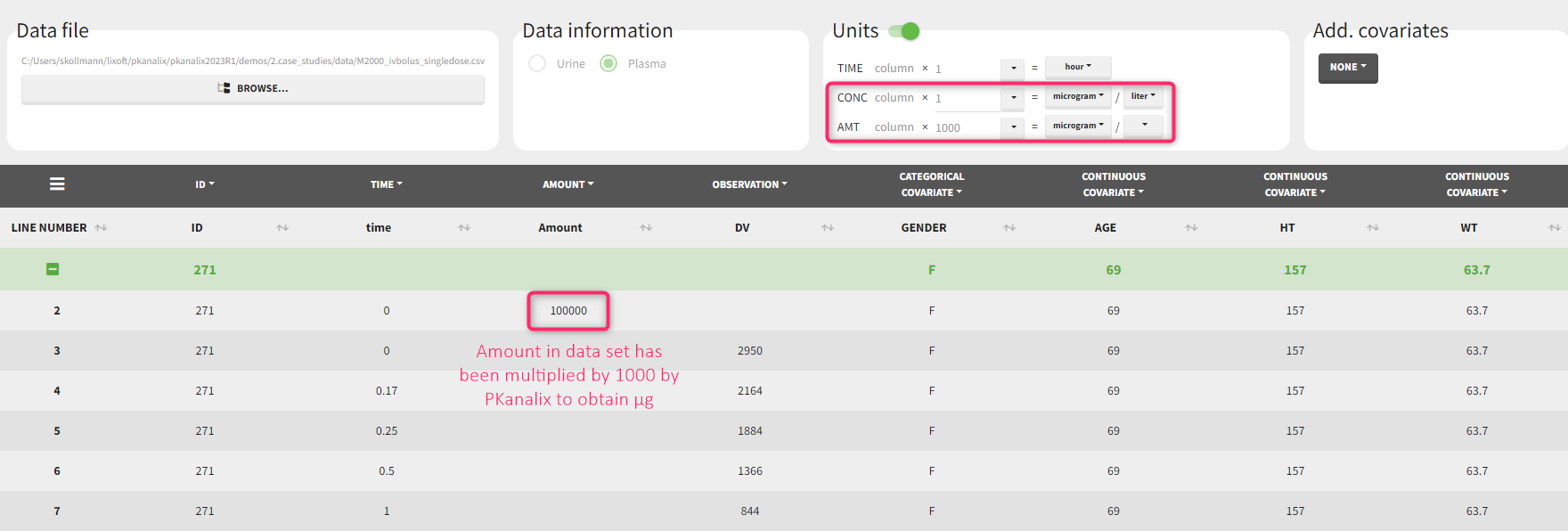
If we would like to have the output NCA parameters using [ng] and [mL], we can define the CONC units as [ng/mL] (as the data set input units) and scale the AMT to convert the amount column from [mg] to [ng] unit with a scaling factor of 1000000.
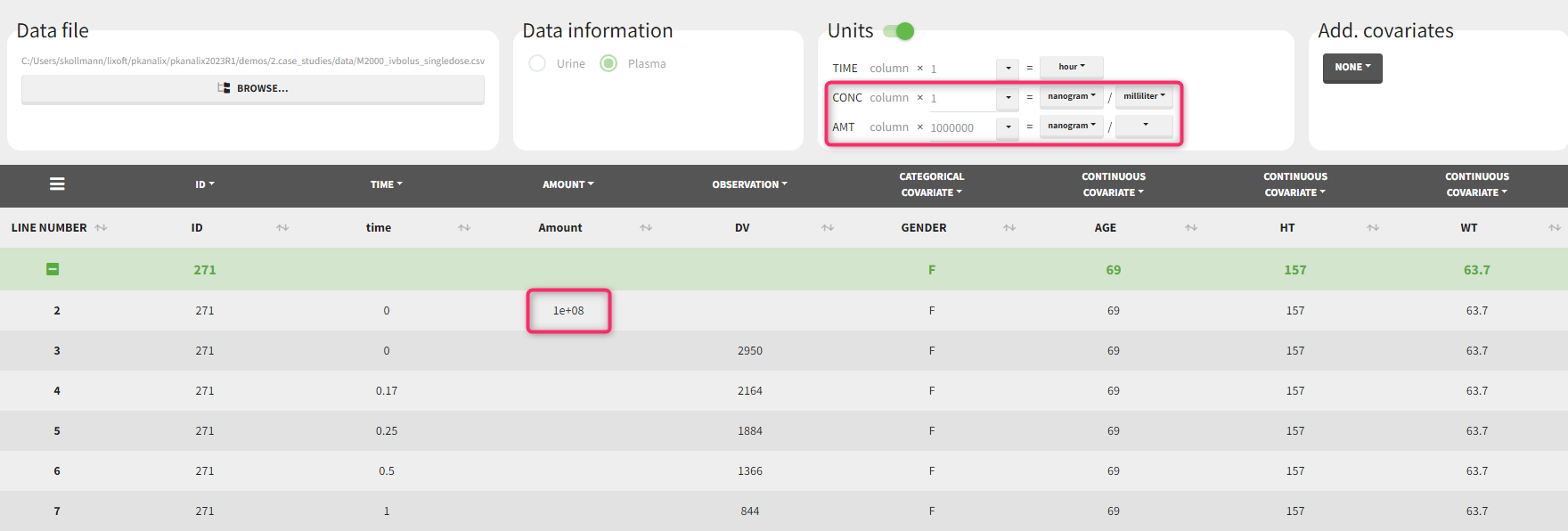
Units for the NCA parameters
Rsq | no unit |
Rsq_adjusted | no unit |
Corr_XY | no unit |
No_points_lambda_z | no unit |
Lambda_z | time-1 |
Lambda_z_lower | time |
Lambda_z_upper | time |
HL_lambda_z | time |
Span | no unit |
Lambda_z_intercept | no unit |
T0 | time |
Tlag | time |
Tmax_Rate | time |
Max_Rate | amount.time-1 |
Mid_Pt_last | time |
Rate_last | amount.time-1 |
Rate_last_pred | amount.time-1 |
AURC_last | amount |
AURC_last_D | grading |
Vol_UR | volume |
Amount_recovered | amount |
Percent_recovered | % [not calculable when grading -> set as NaN] |
AURC_all | amount |
AURC_INF_obs | amount |
AURC_PerCentExtrap_obs | % |
AURC_INF_pred | amount |
AURC_PerCentExtrap_pred | % |
C0 | amount.volume-1 |
Tmin | time |
Cmin | amount.volume-1 |
Tmax | time |
Cmax | amount.volume-1 |
Cmax_D | grading.volume-1 |
Tlast | time |
Clast | amount.volume-1 |
AUClast | time.amount.volume-1 |
AUClast_D | grading.time.volume-1 |
AUMClast | time2.amount.volume-1 |
AUCall | time.amount.volume-1 |
AUCINF_obs | time.amount.volume-1 |
AUCINF_D_obs | grading.time.volume-1 |
AUCINF_pred | time.amount.volume-1 |
AUCINF_D_pred | grading.time.volume-1 |
AUC_PerCentExtrap_obs | % |
AUC_PerCentBack_Ext_obs | % |
AUMCINF_obs | time2.amount.volume-1 |
AUMC_PerCentExtrap_obs | % |
Vz_F_obs | volume.grading-1 |
Cl_F_obs | volume.time-1.grading-1 |
Cl_obs | volume.time-1.grading-1 |
Cl_pred | volume.time-1.grading-1 |
Vss_obs | volume.grading-1 |
Clast_pred | amount.volume-1 |
AUC_PerCentExtrap_pred | % |
AUC_PerCentBack_Ext_pred | % |
AUMCINF_pred | time2.amount.volume-1 |
AUMC_PerCentExtrap_pred | % |
Vz_F_pred | volume.grading-1 |
Cl_F_pred | volume.time-1.grading-1 |
Vss_pred | volume.grading-1 |
Tau | time |
Ctau | amount.volume-1 |
Ctrough | amount.volume-1 |
AUC_TAU | time.amount.volume-1 |
AUC_TAU_D | grading.time.volume-1 |
AUC_TAU_PerCentExtrap | % |
AUMC_TAU | time2.amount.volume-1 |
Vz | volume.grading-1 |
Vz_obs | volume.grading-1 |
Vz_pred | volume.grading-1 |
Vz_F | volume.grading-1 |
CLss_F | volume.time-1.grading-1 |
CLss | volume.time-1.grading-1 |
CAvg | amount.volume-1 |
FluctuationPerCent | % |
FluctuationPerCent_Tau | % |
Accumulation_index | no unit |
Swing | no unit |
Swing_Tau | no unit |
Dose | amount.grading-1 |
N_Samples | no unit |
MRTlast | time |
MRTINF_obs | time |
MRTINF_pred | time |
AUC_lower_upper | time.amount/volume |
AUC_lower_upper_D | grading.time.volume-1 |
CAVG_lower_upper | amount/volume |
AURC_lower_upper | amount |
AURC_lower_upper_D | grading |
Units for the PK parameters
Units are available only in PKanalix. When exporting a project to Monolix, values of PK parameters are re-converted to the original dataset unit. Below, volumeFactor is defined implicitly as: volumeFactor=amtFactor/concFacto, where “factor” is the scaling factor used in the “Units” block in the Data tab.
PARAMETER | UNIT | INVERSE of UNITS |
V (V1, V2, V3) | volume.grading-1 | value/volumeFactor |
k (ka, k12, k21, k31, k13, Ktr) | 1/time | value*timeFactor |
Cl, Q (Q2, Q3) | volume/time.grading-1 | value*timeFactor/volumeFactor |
Vm | amount/time.grading-1 | value*timeFactor/amountFactor |
Km | concentration | value/concFactor |
T (Tk0, Tlag, Mtt) | time | value/timeFactor |
alpha, beta, gamma | 1/time | value*timeFactor |
A, B, C | grading/volume | value*volumeFactor |
Units display
To visualise units, switch on the “units toggle” and accept a dataset. Then, after running the NCA and CA tasks, units are displayed:
In the results table next to the parameter name (violet frame), in the table copied with “copy” button
 (blue frame) and in the saved .txt files in the result folder (green frame).
(blue frame) and in the saved .txt files in the result folder (green frame).
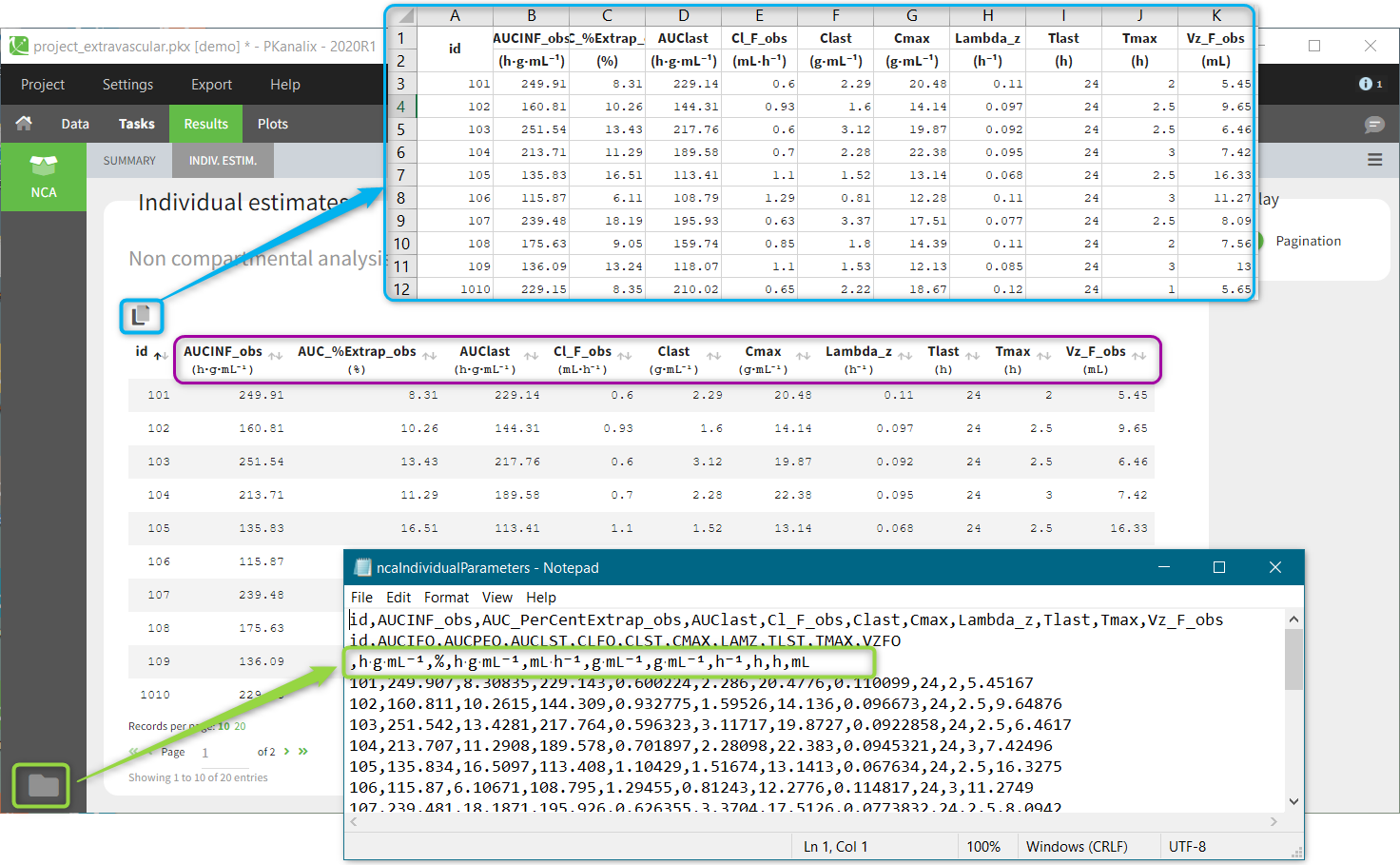
On plots if the “units” display is switched on in the General plots settings
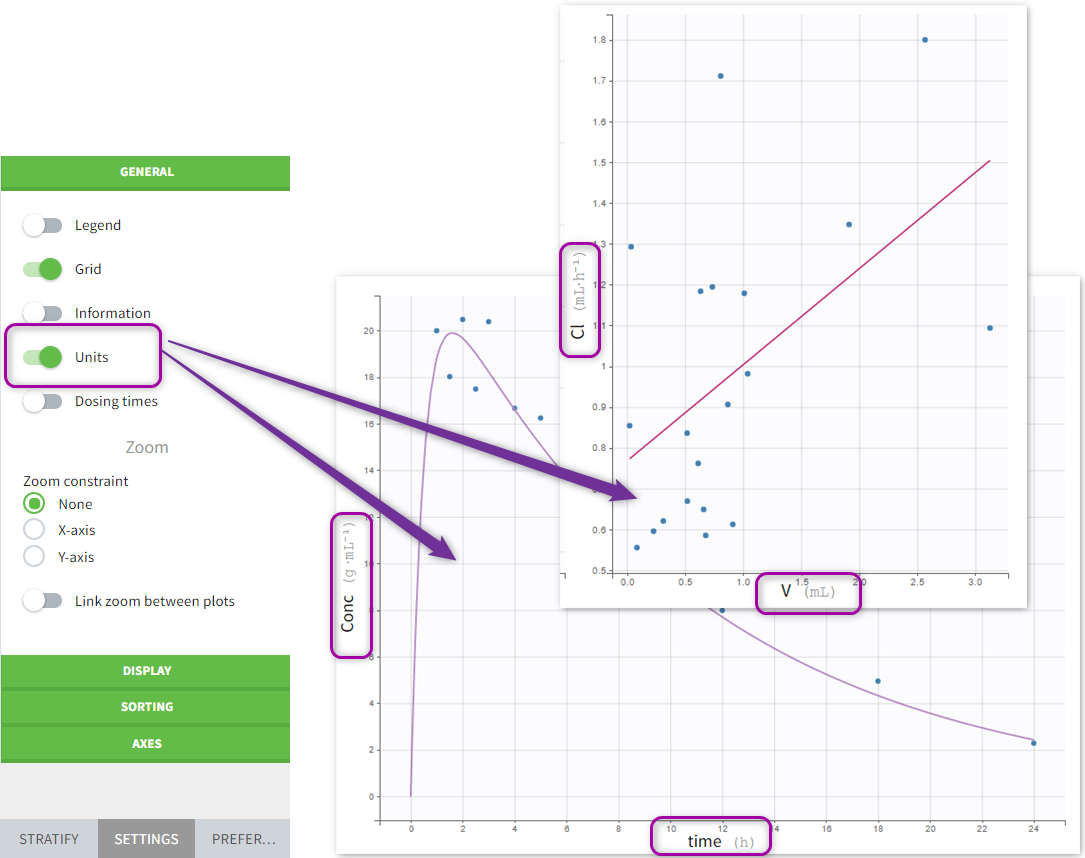
Units preferences
The units selected by default when starting a new PKanalix project can be chosen in the menu Settings > Preferences.
